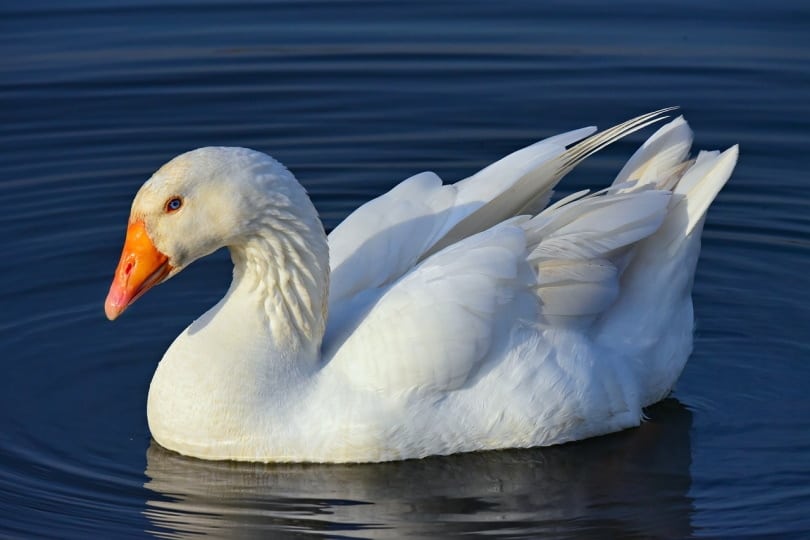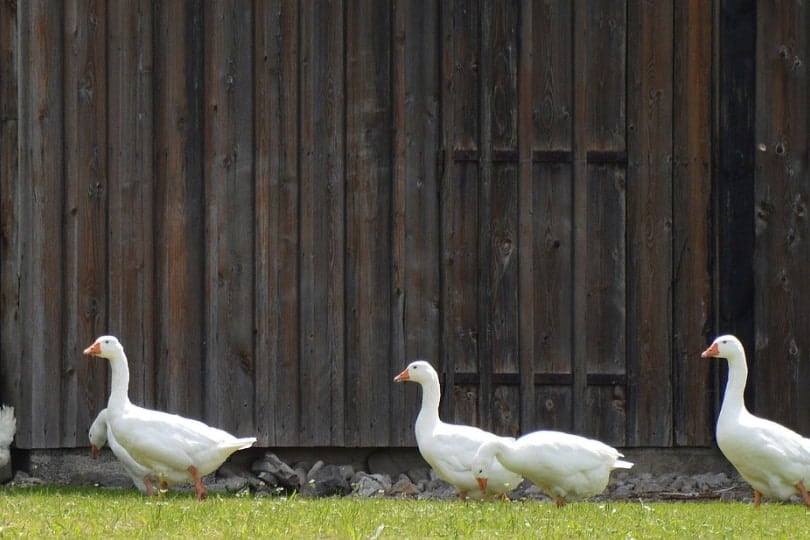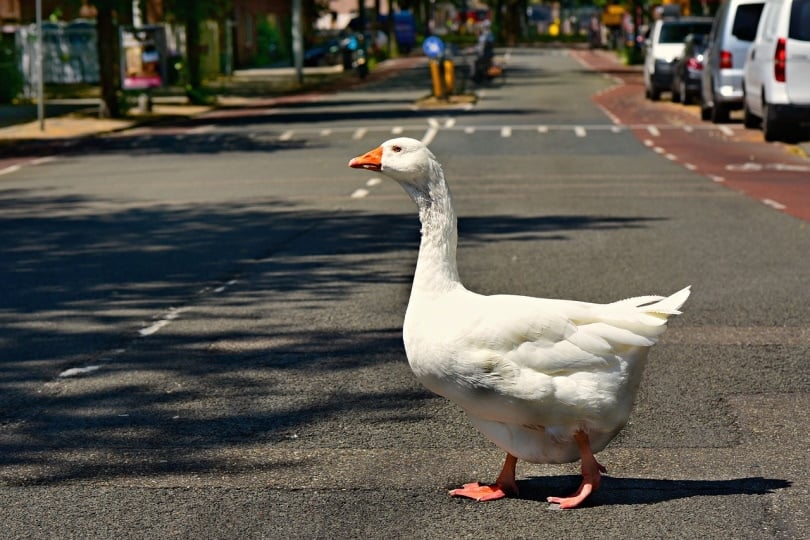Any small-scale farmer, or anyone for that matter, would probably love to own the proverbial goose who lays golden eggs. The Embden goose may not lay such eggs (they’re white actually) but they still offer a golden opportunity for cash flow thanks to their versatility. Read on to learn more about these multi-purpose birds and discover whether they might be the right choice for you.
Click to Skip Ahead:

Quick Facts About The Embden Goose
| Breed Name: | Embden, Bremen, Emden |
| Place of Origin: | Northern Europe, likely Germany |
| Uses: | Meat production, weed control |
| Gander (Male) Size: | 24 – 31 pounds (11 – 14 kg) |
| Goose (Female) Size: | 20 – 24 pounds (9 – 11 kg) |
| Color: | White |
| Lifespan: | 20 – 25 years |
| Climate Tolerance: | All climates, cold hardy |
| Care Level: | Easy |
| Production: | 10-30 eggs/year |

Embden Goose Origins

The Embden goose is one of the oldest known domesticated goose breeds. The earliest specimens are believed to originate from northern Europe around 200 years ago. It’s thought the breed was first developed primarily in Germany, with Denmark and Holland the other possible points of origin. The breed was further refined and developed in the United Kingdom.
Embden geese were first brought to the United States in 1821. In America, they were first called Bremen geese and are sometimes still known by that name in this country.
Embden Goose Characteristics
The Embden goose is one of the most commonly raised breeds of domestic goose. They are one of the tallest and heaviest geese, making them a popular meat bird. Embdens also grow quickly compared to other geese, reaching maturity in 2-3 years.
Embdens are strong, hardy birds, tolerant of a wide variety of climates. Perhaps because of their northern European origins, they are especially good at handling cold temperatures.
These geese are fairly quiet overall, with males being more vocal and shriller than the females. They will sound the alarm if they sense danger. Embden geese are generally calm in temperament, although the males can become aggressive if protecting their flock.
Embden geese can be kept in pairs or as a flock. They can co-exist and even interbreed with other large geese varieties. However, Embden geese can be bullies and should not be kept with smaller, more docile poultry.
The breed typically lays 10-30 eggs per year, usually beginning the breeding season in February. Eggs incubate for about a month, 28-34 days. Embden geese are known for being excellent parents, another reason for their popularity.

Uses
Embden geese are most commonly raised for their meat since they produce few eggs compared to hen chickens. Their size and fast growth rate make them a popular choice for commercial meat production.
When allowed to forage for themselves, Embden geese make excellent weed eaters and are often used as a means of organic weed control. They’re often so effective that no other type of weed management is even needed.

Appearance & Varieties
Embden geese are the tallest and heaviest of the domesticated geese breeds. Their bodies are stocky and round, with short legs and tails. They have a long, curved neck with an oval-shaped head.
The feathers of the Embden goose are pure white, with orange feet and beaks. Their eyes are a distinctive shade of light blue. They have strong wings and are excellent flyers.
Both male and female adult Embdens are similar in appearance, which can make it difficult to tell them apart. Males tend to be a little heavier and display more aggressive behaviors than females.
The easiest time to sex these geese is within the first day after they hatch. Hatchlings are covered in gray down and males are noticeably lighter than females, although only for about 24 hours.

Distribution
As we mentioned, Embden geese are the most popular meat-producing goose breed, and their temperature tolerance allows them to be raised in a wide variety of locations. They are common in both Europe and the United States, especially for commercial meat production.
Embdens are one of the breeds that have been successfully introduced into developing countries, including those with tropical climates.
Embden geese can easily and economically be kept as free-range birds, thanks to their size and foraging ability. They can sustain themselves on plant matter, insects, and other invertebrates, with only small amounts of supplementary food required.

Are Embden Geese Good for Small-Scale Farming?
All geese, including Embden geese, make excellent poultry options for small-scale farming. Geese are less complicated to keep than chickens because they are independent and less vulnerable to predators due to their size. Their superior foraging skills make them cheap to feed.
Small-scale farms need to get the most use possible from the animals they raise to maximize their income potential. Embden geese are useful for meat, eggs, weed control, as watch birds for smaller poultry, and as a source of feathers and down for clothing.

Conclusion
As you can see, Embden geese could be the perfect addition to your backyard flock or homestead. Not only are they cost-effective to raise, but they’ll likely save you time and money on weed-eating or landscapers. If you’re preparing to start a flock, think hard about whether it’s worth your while to make the Embden goose part of your plans.
See also:
Featured Image Credit: MabelAmber, Pixabay
